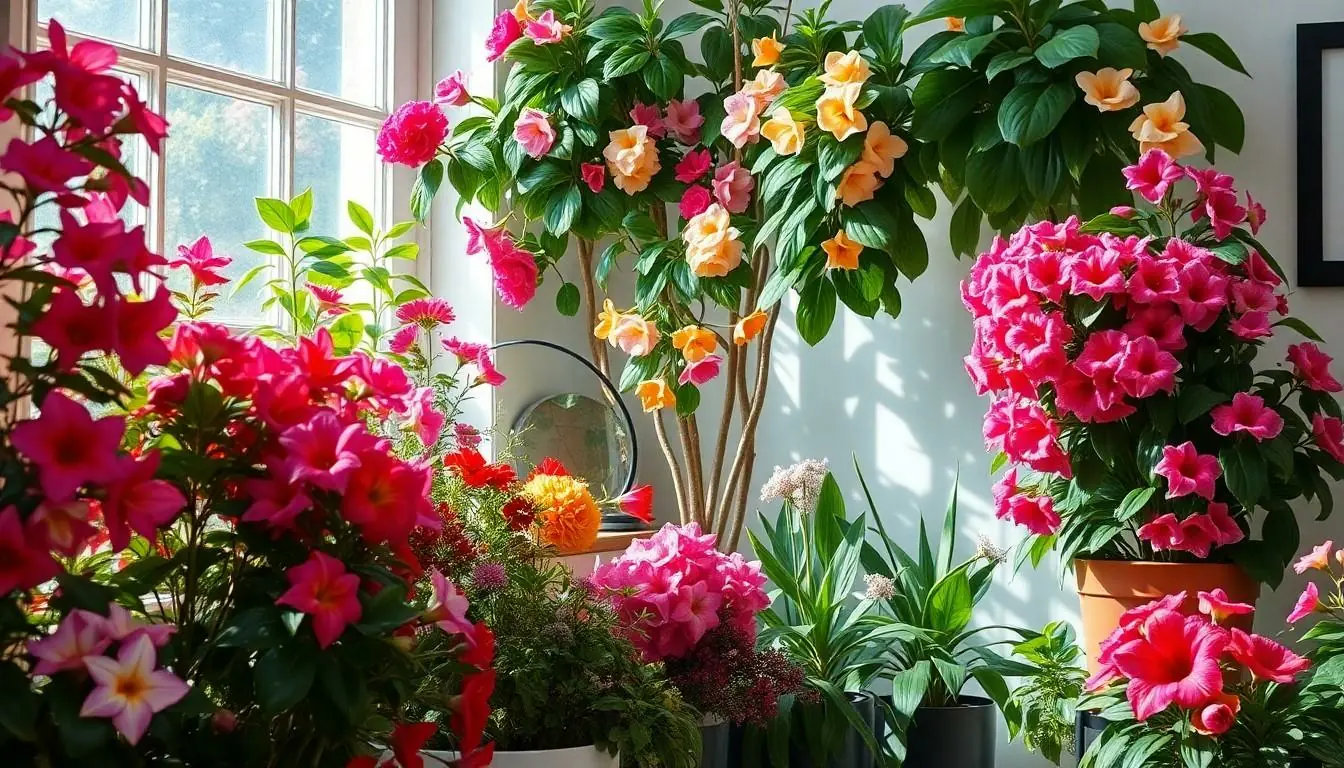Table of Contents
ToggleIndoor flowering house plants are the perfect way to bring a splash of color and a breath of fresh air into any space. Imagine stepping into your living room and being greeted by vibrant blooms that not only please the eye but also purify the air. It’s like having a mini garden party right at home, minus the awkward small talk.
Overview of Indoor Flowering House Plants
Indoor flowering house plants enhance home environments with vibrant colors and fragrances. Various species thrive indoors, proving their aesthetic and functional value. These plants transform spaces into lively and inviting areas while contributing positively to indoor air quality.
Selecting the right indoor flowering house plants involves considering light conditions and room temperature. Popular choices include the African violet, peace lily, and money plant. Each plant has unique lighting requirements and care instructions, which impact blooming frequency and health.
African violets, known for their long-lasting blooms, thrive in bright, indirect light. Peace lilies, with their elegant white flowers, perform well in low-light conditions and filter toxic chemicals from the air. Money plants, or pothos, produce cascading vines and adapt to different environments, making them versatile options for any room.
Incorporating water and humidity levels into the care routine is essential. Specific flowering plants prefer consistently moist soil, while others require drying out between waterings. Mist or use humidity trays to maintain optimal moisture, supporting healthy growth.
Flowering house plants create focal points and enhance the overall decor. Displaying them near windows or in group arrangements draws attention and adds depth to interior design. Additionally, blooming plants provide seasonal changes, allowing for dynamic home decoration.
Indoor flowering house plants contribute to well-being, offering natural beauty and air purification benefits. They create a mini garden party atmosphere, improving mood and reducing stress in living spaces. Understanding their care and characteristics ensures successful growth and enjoyment of these vibrant additions.
Benefits of Indoor Flowering House Plants

Indoor flowering house plants offer multiple advantages that enhance living spaces and improve quality of life. Their vibrant blooms create a cheerful atmosphere while promoting health benefits.
Aesthetic Appeal
Colorful petals and lush greenery significantly elevate home decor. These plants act as focal points in any room, adding charm and personality. Varieties like African violets and peace lilies provide unique textures and hues, enhancing visual interest. Incorporating different species brings diversity to interior design. Positioning plants near windows or in common areas maximizes their impact, transforming spaces into lively retreats. Visual satisfaction comes from the allure of flowering plants, contributing to a welcoming environment.
Health Benefits
Indoor flowering plants contribute positively to well-being and health. They improve indoor air quality by filtering toxins and releasing oxygen. NASA’s Clean Air Study identifies several plants as effective in removing pollutants. Reduced stress levels often result from being surrounded by greenery and nature. Additionally, the presence of these plants can elevate mood and increase focus. Even caring for plants fosters feelings of responsibility and accomplishment. Overall, indoor flowering plants not only beautify spaces but also promote physical and emotional health.
Popular Indoor Flowering House Plants
Indoor flowering house plants create vibrant atmospheres, complementing home decor while providing numerous benefits. A variety of options exist, each with unique qualities and care needs.
African Violets
African violets thrive in low to medium light, offering stunning blooms in shades of purple, pink, and white. Their soil should remain consistently moist but not soggy, with regular watering using room-temperature water recommended. Fertilization every 4 to 6 weeks during the growing season promotes healthy growth and flowering. These plants benefit from humidity, so placing them in bathrooms or using a humidity tray helps maintain adequate moisture levels. African violets typically bloom year-round, making them a delightful addition to any indoor space.
Peace Lilies
Peace lilies excel in low light conditions and produce elegant, white blooms throughout the year. They prefer consistently moist soil, blooming best when watered weekly. These plants indicate their needs by drooping slightly, signaling that it’s time for watering. Fertilization can occur once a month during the spring and summer months to encourage growth. To enhance air quality, peace lilies actively filter toxins from the environment, making them an excellent choice for living rooms and bedrooms.
Orchids
Orchids require bright, indirect light and thrive in well-draining potting media designed for orchids, often consisting of bark or sphagnum moss. Watering every 1 to 2 weeks allows roots to dry out between sessions, preventing rot. Fertilizing every 2 to 4 weeks during the growing season promotes blooming. Some varieties, like Phalaenopsis, offer long-lasting flowers that add elegance to any room. Orchids enhance aesthetic appeal and represent love and beauty, making them a favored option among house plant enthusiasts.
Care Tips for Indoor Flowering House Plants
Caring for indoor flowering house plants involves understanding their specific needs. Proper attention ensures vibrant blooms and healthy foliage.
Light Requirements
Bright, indirect light benefits most indoor flowering plants. African violets thrive in low to medium light, while orchids prefer bright, indirect light. Peace lilies adapt well to low light but still bloom better in brighter conditions. Position plants near east or west-facing windows to maximize light exposure. Use sheer curtains to diffuse harsh sunlight if necessary. Monitor plant responses, as yellow leaves indicate light issues.
Watering Techniques
Watering techniques play a crucial role in plant health. Most indoor flowering plants prefer consistently moist soil but shouldn’t sit in water. Checking the top inch of soil for dryness before watering is essential. Water until it drains from the bottom for even moisture distribution. Peace lilies droop when thirsty, signaling the need for water. Adjust watering frequency based on seasonal changes and humidity levels in the environment.
Soil and Fertilization
Choosing the right soil mixture supports healthy growth. Well-draining potting mix accommodates indoor flowering plants effectively. Using a blend specific for house plants maintains good aeration and moisture retention. Fertilization should occur every four to six weeks during the growing season. Organic fertilizers promote steady growth without the risk of chemical build-up. Tailor the fertilizer type to individual plant needs for optimal blooming results.
Troubleshooting Common Issues
Common issues arise with indoor flowering house plants, but many can be easily addressed through proper management and preventive measures.
Pest Management
Pests can threaten indoor plants, commonly including aphids, spider mites, and mealybugs. Regularly inspecting the foliage aids in identifying these pests early. Neem oil serves as an effective treatment, providing both pest control and a protective barrier. Insecticidal soap also targets soft-bodied insects without harming the plants. Vacuuming infested areas can help remove pests as well. Regularly cleaning leaves improves air circulation and reduces the likelihood of infestations.
Disease Prevention
Disease can affect indoor plants, manifesting as wilting, yellowing leaves, or mold growth. Proper watering practices prevent root rot; it’s vital to allow soil to dry slightly between waterings. Choosing well-draining potting mixes promotes healthy root systems. Maintaining adequate humidity, ideally around 40-60%, minimizes the risk of fungal diseases. Air circulation plays a crucial role; placing plants in well-ventilated areas reduces moisture buildup. Checking for signs of disease early allows for timely intervention, enhancing the plants’ health and longevity.
Indoor flowering house plants offer a unique blend of beauty and health benefits that can transform any living space. By selecting the right varieties and understanding their care requirements, anyone can enjoy vibrant blooms and lush greenery year-round. These plants not only enhance decor but also improve air quality and elevate mood, making them essential companions in daily life.
With proper attention to light, water, and humidity, indoor plants thrive and bring a sense of accomplishment to their caretakers. Embracing indoor flowering plants is an enriching experience that fosters a connection to nature, creating a cheerful and inviting atmosphere at home.




